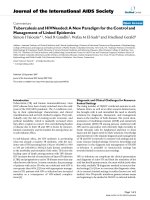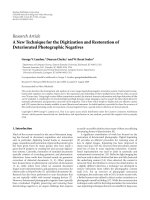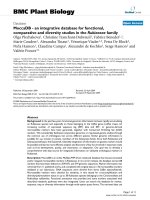New materials for organic semiconductors and organic dielectries synthesis, characterization and theoretical studies
Bạn đang xem bản rút gọn của tài liệu. Xem và tải ngay bản đầy đủ của tài liệu tại đây (4 MB, 157 trang )
NEW MATERIALS FOR ORGANIC
SEMICONDUCTORS AND ORGANIC DIELECTRICS:
SYNTHESIS, CHARACTERIZATION AND
THEORETICAL STUDIES
CHE HUIJUAN
(M.Sc., HNU)
A THESIS SUBMITTED
FOR THE DEGREE OF DOCTOR OF PHILOSOPHY
DEPARTMENT OF CHEMISTRY
NATIONAL UNIVERSITY OF SINGAPORE
2009
i
ACKNOWLEDGEMENTS
I am deeply indebted to many people without whom my research work would not be
possible.
First and foremost, I would like to thank my supervisor, Prof. Hardy Chan,
for his instruction, advice, encouragement and support over the past four plus
years. He has always been there listening to me and offering me help whenever
needed regardless how small or what the problem was. His knowledge,
excitement and enthusiasm have made my graduate experience enjoyable and
memorable.
I would also like to thank my co-supervisor, Dr. Peter Ho, for his guidance
and supervision, particularly in the field of physics. He always has both eyes open
and let no suspicious results escape. I thank him for all the valuable advice and
support he has given me.
My appreciation also goes to all the members in the Functional Polymer
Laboratory. In particular, I would like to thank Xia Haibing, Tang Jiecong, Cheng
Daming, Liu Xiao, Zhang Sheng, Xu Changhua, Fan Dongmei and Wen Tao for
their valuable help and advice in the synthesis and characterization of organic
materials.
Special thanks to Organic Nano Device Laboratory (ONDL). In particular, I
wish to thank Chua Lay-Lay, Chia Perq-Jon, Sankaran Sivaramakrishnan, Zhou
ii
Mi, Wong Loke-Yuen, Zhao Lihong, and Roland Goh for their friendly help in
device fabrication and device characterization.
I would like to express my gratitude to the National University of Singapore
for the research scholarship and for providing the opportunity and facilities to
carry out the research work.
Lastly, thanks to my parents and all my friends for their love and support.
iii
Title: New materials for organic semiconductors and
dielectrics: Synthesis, characterization and theoretical
studies
Acknowledgements………………………………………………… i
Table of Contents……………………………………………………iii
Summary……………………………………………………………vii
Figures and Tables Caption…………………………………… ix
Abbreviations………………………………………………………xiv
Chapter 1 Introduction…………………………………………………………1
1.1 Organic electronics……………………………………………………………2
1.2 Molecular electronics…………………………………………………………3
1.3 Self-assembled monolayer (SAMs)……………………………………………5
1.4 Characterization of molecular electronics……………………………………8
1.4.1 Molecular break junctions……………………………………………9
1.4.2 Nanofabricated pores………………………………………………10
1.4.3 Hanging mercury drop electrodes………………………………… 11
1.4.4 Scanning probe microscopy…………………………………………12
1.4.5 Large-area molecular junctions …………………………………… 14
1.5 Thesis overview………………………………………………………………16
1.6 References……………………………………………………………………18
Chapter 2 Instrumental and experimental……………………………………22
2.1 Chemicals and materials……………………………………………………22
2.1.1 Synthesis of push-pull molecules………………………………… 22
2.1.2 Synthesis of ionic and cationic dyes……………………………… 36
2.2 NMR Spectroscopy…………………………………………………………40
2.3 Mass spectrometry……………………………………………………………41
2.4 Fourier transform infrared (FT-IR) spectroscopy……………………………41
2.5 Gas Chromatograpy /Mass Spectrometry (GC/MS)…………………………41
2.6 Spectroscopic ellipsometry (SE)……………………………………………41
2.7 Ultraviolet Photoelectron Spectroscopy (UPS)………………………………45
iv
2.8 Preparation of gold substrates and self-assembly process……………………46
2.9 Device fabrication and Current-Voltage (I-V) measurement ………………47
2.10 References…………………………………………………………………49
Chapter 3 Large-area molecular rectifier junction based on push-pull
molecules………………………………………………………………………50
3.1 Introduction………………………………………………………………50
3.1.1 P-N junction as classical rectifier………………………………… 50
3.1.2 Aviram-Ratner Model as molecular rectifier……………………… 52
3.1.3 Push-pull molecules as molecular rectifier………………………….53
3.2 Characterization of push-pull thiols as SAMs………………………………55
3.2.1 Thickness measurement by spectroscopic ellipsometry…………….55
3.2.2 Dipole moment calculation………………………………………….58
3.2.3 Work function measurement by UPS……………………………… 58
3.2.4 Molecular conformation model………………………………… 60
3.3 Electrical characterization of rectifying molecular junction devices…….63
3.4 Conclusion ………………………………………………………………… 66
3.5 References …………………………………………………………………68
Chapter 4 Electron conduction in SAMs based on large-area molecular
junctions…………………………………………………………………………72
4.1 Introduction ………………………………………………………………….72
4.1.1 Theory ………………………………………………………… 72
4.1.2 Simmons tunneling model ………………………………………….74
4.2 Experiments ……………………………………………………………….…76
4.2.1 Chemicals and materials ……………………………………………76
4.2.2 Fabrication of molecular junctions based on alkanethiol SAM…… 76
4.3 Results and discussions …………………………………………………… 76
4.3.1 Measurement of molecular length of alkanethiol SAM …………….76
4.3.2 IV characteristics of alkanethiol SAMs molecular junctions ………78
4.3.3 β value determination based on alkanethiol SAMs molecular
junctions ………………………………………………………………… 79
4.3.4 m* determination based on alkanethiol SAMs molecular
junctions … 82
4.3.5 Determination of barrier height in push-pull molecular
v
junctions ………………………………………………………….……….83
4.4 Conclusion …………………………….…………………………………… 86
4.5 References ………………………………………………………………… 88
Chapter 5 Application of ionic assembly technique to molecular
rectifier ……………………………………………………………………… 91
5.1 Introduction ………………………………………………………………….91
5.1.1 Layer-by-layer structures ………………………….……………… 91
5.1.2 Ionic self-assembly (ISA) techniques ………………….………… 93
5.1.3 ISA technique for molecular rectifier applications ……….……… 94
5.2 Synthesis of novel ionic dyes ……………………………………………… 96
5.2.1 Design and preparation of cationic iodide dye ………………….…96
5.2.2 Design and preparation of molecular ruler derivatives …………… 96
5.3 Controlled alignment of cationic molecules on anionic surface …………….97
5.3.1 Formation of ionic self-assembly monitored by SE …………….….97
5.3.2 Work function measurement of ISA by UPS …………………… 99
5.3.3 IV characterization of ISA structure ……………….……………100
5.4 Studies on molecular ruler derivatives ……………………………………101
5.4.1 Ionic self-assembly monitored by SE …………………….……….101
5.4.2 Solvent effect on the ionic assembly process …………………….103
5.5 Conclusion ………………………………….………………………………104
5.6 References ……………………………………….…………………………106
Chapter 6 Attempted synthesis of benzocyclobutene (BCB) derivatives as
dielectric for organic field effect transistors (OFETs)
application ……………………………………………………………………107
6.1 Introduction …………………………………………….…………………107
6.1.1 Organic field-effect transistors (FETs) ………………………… 107
6.1.2 Gate dielectric layer in OFETs ……………………….……………108
6.1.3 Divinyltetramethyldisiloxane-bis(benzocyclobutene) (DVS-bis-BCB)
as gate dielectric ….…………………………………………………110
6.1.4 Novel BCB monomer structure as objective ………………….… 112
6.2 Attempted synthesis of substituted BCB monomer hydrocarbons …….… 114
6.2.1 Thermolysis pathway …………………………….……………… 114
6.2.2 Parham cyclialkylation pathway …………………………….…….119
vi
6.2.3 Alkylation of 1, 2-dibromobenzocyclobutene ………………… 123
6.3 Theoretical studies ………………………………………………………….125
6.3.1 Structure optimization …………………………………………… 125
6.3.2 Energy diagram based on theoretical calculations ……….……… 127
6.4 Conclusion …………………………………………………….……………128
6.5 References ………………………………………………….………………129
Chapter 7 Conclusions and suggestion for future work ………… ……….132
7.1 Conclusion ……………………….…………………………………………132
7.2 Suggestions for future work ……………………………………………… 135
7.3 References ………………………………………………………………….136
vii
Summary
Organic semiconductors and organic dielectrics differ from their inorganic
counterparts in many ways including optical, electronic, chemical and structural
properties. In particular, their electronic properties have aroused much excitement
among scientists as a viable candidate to replace silicon at the nanoscale, due to
ease of processing and low fabrication cost offered by molecular-level control of
properties.
We have prepared robust large-area molecular rectifier junctions from two
series of “push-pull” molecules using a Au/ donor-acceptor self-assembled
monolayers/PEDT/Al sandwich device configuration. These devices show obvious
asymmetric effects under applied bias. The IV characteristics of these rectifying
molecular junctions follow closely the prediction of Simmon’s tunneling theory.
The electron conduction parameters and charge transport mechanism were
investigated. This work shows that robust rectification is possible in solid-state
molecular junction devices.
Molecular large area junction devices based on Au/ HS - ionic <> cationic
D-π-A dye self-assembled monolayers /PEDT/Al were fabricated and
characterized in our attempt to attain molecular rectifier with higher rectification
ratios. A series of dye derivatives with different alkyl lengths (molecular ruler
molecules) was compared in order to study the effect of asymmetric placement of
alkyl chain on the rectification mechanism.
viii
We have attempted to prepare methyl substituted benzocyclobutenes (BCB)
monomer which is widely used in the semiconductor industry. We anticipate that
the electron-donating substituents on the four-member ring of BCB will lower the
polymerization temperature so as to satisfy its properties as dielectric materials in
OFET application. Three synthetic approaches were attempted: i) pyrolysis
method, (ii) Parham’s cycloalkylation pathway and (iii) substitution pathway from
dibromocyclobutene. The pyrolytic synthesis process was carried out on our
improved pyrolysis apparatus and the results were rationalized based on DFT
theoretical calculations.
ix
TABLES CAPTION
Table 2.1 Advantages and disadvantages of spectroscopic ellipsometry
technique
Table 3.1 Properties of SAMs
Table 3.2 Properties of SAMs applied devices
Table 4.1 Summary of alkanethiol tunneling characteristic parameters by
different test structures
Table 5.1 Methods of self-assembly which involve secondary interactions
Table 5.2 Work function data from UPS
Table 5.3 The experimental and theoretical thickness comparison
Table 5.4 The experimental and theoretical thickness comparison with
different solvent
Table 6.1 Pyrolysis conditions and product observed
Table 6.2 Calculated energies of benzocyclobutenes at Becke3LYP/6-311G (d,
p) level
x
FIGURES CAPTION
Figure 1.1 Formation of a self-assembled monolayer by surface adsorption
Figure 1.2 Idealized schematic of a break junction experiment
Figure 1.3 Idealized schematic of a nano-pore junction device used for
molecular transport measurement
Figure 1.4 Molecular bilayer junction formed by the hanging mercury drop
Figure 1.5 Formation of a molecular junction based on metal-coated CP-AFM
tip with self-assembled monolayer on a planar electrode
Figure 1.6 Processing steps of large-area molecular junctions
Figure 2.1 The basic components of an ellipsometer
Figure 2.2 Schematic representation of a single molecular junction
Figure 3.1 Schematic of p-n junction made from a single crystal modified in
two separate regions. (a) The majority carriers are holes in p region
(left), while the majority carriers are electrons in n region (right). (b)
Variation of the hole and electron concentrations across an unbiased
(zero applied voltage) junction. (c) Electrostatic potential from
positive (+) and negative (-) ions near the junction.
Figure 3.2 Current-voltage behaviors in a p-n junction
Figure 3.3 The Aviram-Ratner model molecule
Figure 3.4 Energy-level diagrams of AR model (D: donor; A: acceptor)
Figure 3.5 Chemical structures of SAM compounds (compound 4, 7, 14 and
21)
Figure 3.6 SAM film thickness–time plots measured on Au
Figure 3.7 UPS spectra of (left) the low-energy-cutoff (LECO) and (right)
Fermi
Figure 3.8 Molecular models of the SAM molecules
xi
Figure 3.9 Electrical characteristics of the molecular junction (a) Log – lin jV
characteristics for compound 14 (4 devices). (b) Log–lin jV for
compound 21 (5 devices) showing (weak) rectification in the
opposite polarity.
Figure 3.10 Log–lin jV characteristics of a C14SH junction and a “shorted”
junction with no SAM are also shown for comparison
Figure 4.1 Transimission of electron wave function through potential barrier.
Figure 4.2 Comparison of Ellipsometry thickness and theoretical width of
monolayers of alkanethiols. (Square: molecular width by theoretical
calculation; Circle: Ellipsometry experimental thickness +3.5Å)
Figure 4.3 Effective mass dependence on barrier height in previous reports
Figure 4.4 Log–lin jV characteristics of C8SH and C12SH junctions
Figure 4.5 Log J versus the tunneling width for C8SH and C12SH molecular
junctions
Figure 4.6 Simmons tunneling fitting of C14SH molecular junction behavior
(red dots line is experimental IV characteristic; black solid line is
Simmons model)
Figure 4.7 Electrical jV characteristics of the push-pull molecules (compound
4, 7, 14 and 21) in the cross-wire molecular junctions: Au/
tail-D– –A or tail-A– –D/ PEDT: PSSH/ Al. The calculated jV
characteristics for a symmetrical tunnel junction according to
Simmon’s theory for the barrier height are also shown. Thick
solid line = Simmons tunnel model. (a) Log–lin current
density–voltage (jV) characteristics for compound 4 molecular
junctions (6 devices); (b) Log–lin jV characteristics for compound
14 (6 devices); (c) Log–lin jV characteristics for compound 7 (4
devices); (d) Log–lin jV characteristics for compound 21 (5
devices).
Figure 5.1 ISA schematic for buildup of multilayer assemblies by consecutive
adsorption of anionic and cationic polyelectrolyte from aqueous
solution
Figure 5.2 Bi-layer structure formed from ionic assembly technique
xii
Figure 5.3 Chemical structures of compounds 23 and 24
Figure 5.4 Chemical structures of C10, C8 and C4 tail dye
Figure 5.5 UPS spectra of the low-energy-cut-off (LECO)
Figure 5.6 Electrical IV characteristics of the molecular junction for dye 23 (4
devices) and dye 24 (4 devices)
Figure 5.5 The bilayer structure (C10 tail dye as cationic layer)
Figure 6.1 The schematic structure of OFET
Figure 6.2 Apparatus setup for the pyrolysis
Figure 6.3 Energy barrier diagram of different structures
xiii
SCHEMES CAPTION
Scheme 2.1 Synthesis routes for compound 4
Scheme 2.2 Synthesis routes for compound 7
Scheme 2.3 Synthesis routes for compound 14
Scheme 2.4 Synthesis routes for compound 21
Scheme 2.5 Synthesis routes for iodide dyes
Scheme 2.6 Synthesis routes for compound 27 (C10 tail dye)
Scheme 2.7 Chemical structures of C4 tail dye and C8 tail dye
Scheme 5.1 Representative ionic assembly architecture of dye 23
Scheme 5.2 The bi-layer ionic assembly architecture (C10 tail dye as cationic
layer)
Scheme 6.1 Formation of DVS-bis-BCB polymer network
Scheme 6.2 Chemical structures of compound a and compound b
Scheme 6.3 Synthesis route to DVS-bis-BCB
Scheme 6.4 Synthesis route to BCB hydrocarbon (a
) via thermolysis
Scheme 6.5 Mechanism of the thermal extrusion of sulphur dioxide
Scheme 6.6 Schematic diagram of the compound (b
) preparation
Scheme 6.7 Possible side reaction pathways
Scheme 6.8 Synthesis routes for the third method
Scheme 6.9 Optimization structures
xiv
ABBREVAITONS
∆ barrier height
Å Angstrom
A Acceptor
AFM Atomic force microscopy
AIBN azobisisobutyronitrile
Al Aluminum
AM1 Austin model 1
Au Gold
BCB benzocyclobutene
C12SH Dodecanethiol
C14SH Tetradecanethiol
C8SH Octanethiol
C-AFM Conducting AFM
CH
2
Cl
2
Dichloromethane
CHCl
3
chloroform
cm centimeter
cm
-1
wave number
D Donor
DCM Dichloromethane
xv
DFT
Density Functional Theory
DMF N, N-dimethyformamide
DMSO dimethyl sulfoxide
E Electron energy
e Electron charge
Ec Conduction band bottom energy
E
f
Fermi energy
eV electron volts
Ev Valence band top energy
φ
work-function
FT-IR Fourier transform infrared
FVP Flash vacuum pyrolysis
g gram
G Conductance
GC/MS Gas Chromatograpy /Mass Spectrometry
h Plank’s constant
HCl hydrogen chloride
HOMO highest occupied molecular orbital
ISA ionic self-assembly
IV Current-voltage characteristic
j
V Current density-volotage characteristic
xvi
k
Boltzman’s constant
K
2
CO
3
Potassium carbonate
LB Langmuir-blodgett
LDA lithium diisopropylamine solution
LUMO lowest unoccupied molecular orbital
m Electron mass
m* Effective electron mass
MEOH Methanol
mg milligram
MgSO
4
magnesium sulfate
mL milliliter
mM milimole
MOPAC molecular package
MS Mass Sepctroscopy
Na
2
SO
4
Sodium sulfate
NaHCO
3
Sodium hydrocarbonate
NaI Sodium iodide
NaOH Sodium hydroxide
NBS N-bromosuccinimide
nm nanometer
NMR nuclear magnetic resonance
xvii
OFET
Organic Field Effect Transistors
PCC Pyridinium Chlorochromate
PEDT Poly(3,4-ethylenedioxythiophene)
POCl
3
Phosphoryl chloride
PSSH poly(styrenesulfonate)
RT Room Temperature
S Sulfur
SAM Self Assembled Monolayer
SE Spectroscopic Ellipsometry
Si silicon
STM scanning tunneling microscopy
T time
TCNQ Tetracyanoquinodimethane
THF tetrahydrofuran
TMS tetramethylsilane
TTF Tetrathiafulvalene
UPS Ultraviolet Photoelectron Spectroscopy
UV-Vis ultraviolet-visible
V volts
V volume
WKB Wentzel–Kramers–Brillouin approximation
xviii
XPS
X-ray photoelectron spectroscopy
ZPE zero-point energies
α Simmons equation fitting parameter
β
Tunneling decay coefficient
ε Dielectric constant
λ wavelength
Ψ psi
1
Chapter 1
Introduction
For the past forty years, inorganic silicon and gallium arsenide
semiconductors, silicon dioxide insulators, and metals such as aluminum and
copper have been the backbone of the semiconductor industry. However, the
increasing demand for smaller and high powered electronics has driven inorganic
electronics close to its physical limits. According to the Moore’s Law prediction,
the miniaturization of the devices in integrated circuits will be reaching atomic
dimensions by 2014 [1]. One of the fundamental limits to the miniaturization of
silicon devices lies in the gate oxide technology [2]. The limit to oxide thickness
is inherent and cannot simply be overcome by technological improvements.
Several other important technological issues are also raised as device size
continues to shrink.
To overcome this physical limit, the science and engineering community
and the semiconductor industry will have to come up with new ideas to avoid a
bottle neck in growth. As a possible substitution, research in organic electronics
technology started in the early 80’s and developed enormously in recent years as a
result of a multidisciplinary approach involving chemistry, physics, electrical
engineering and materials science. The main research effort in organic electronics
has been focused on the improving the semiconducting, conducting, and light-
emitting properties of organic (polymers, oligomers) and hybrids (organic–
inorganic composites) through novel synthesis and processing techniques.
Universities, national laboratories, defense organizations worldwide, and
2
companies such as Philips, IBM, Motorola, and Siemens are actively engaged in
the R&D of organic electronics.
1.1 Organic electronics
Organic electronics [3, 4] is becoming a promising field because it offers a
number of advantages compared to traditional inorganic electronics technology.
These advantages include: i) ease of fabrication at much lower temperatures at
ambient conditions; ii) relatively large scale and inexpensive production process;
iii) possibility of making composites and blends with other polymer and inorganic
materials; iv) tunable mechanical and chemical properties (e.g. solubility, strain-
stress and cross-linking properties). All these performance improvements, coupled
with the ability to process these “active” materials at low temperatures over large
areas on plastic or paper substrate, will open up new technologies which lead to
novel applications.
Organic materials in electronic application may often be solution-
processed. Such special properties allow the fabrication of devices such as circuits,
display, and radio-frequency identification devices on plastic substrates, and
deposition by much cheaper techniques, such as screen and inkjet printing. The
most attractive prospect, however, is the incorporation of functionality by design.
The versatility of organic synthetic techniques and the wide spectrum of
commercially available building blocks allow infinite flexibility in fine-tuning
molecular structure and the corresponding molecular packing and control of
macroscopic properties, with an aim to achieve specific performance indicators.
3
Materials used in organic electronic technology can be divided into three
main groups: i) organic dielectrics; ii) organic semiconductors; and iii) organic
conductors. Among the three types of organic materials, organic dielectrics has
been intensively investigated and has been used in capacitors, piezo-electronics,
and other electronic devices applications [5, 6]. Organic semiconductors has been
used as active components in field-effect devices, light emitters, laser emitters,
energy conversion devices, and sensors [7, 8]. Organic conducting polymers have
been used for charge transporting applications (contacts and electrodes) and as
sensor/actuators [9, 10].
To create organic electronics from organic molecules, scientists and
engineers have been pursuing two distinct but related routes [11]. One approach
aims to exploit charge transfer through a single molecule or modulate the
properties of a single molecule electronically (i.e. molecular electronics). The
other approach is based on charge transport through molecular assemblies. This
thesis focuses on the first approach because the field of molecular electronics is
still in its infancy with many unanswered questions and new areas to be explored.
1.2 Molecular electronics
The semiconductor industry has seen a remarkable miniaturization trend,
driven by many scientific and technological innovations. But if this trend is to
continue, and provide even faster and cheaper computers, the size of
microelectronic circuit components will soon need to reach the scale of molecules
[12], a goal that will require new device structures. The idea that a few molecules,
or even a single molecule, could be embedded between electrodes and perform the
4
basic functions of digital electronics such as rectification, amplification and
storage, is both interesting and challenging. Scientists would agree that the
concept of molecular electronics is now realizable for individual components, but
the fabrication of complete circuits at the molecular level remains an uphill task
because of the difficulty of connecting molecules to each another.
Molecular electronics can be defined as technology utilizing single
molecules, small groups of molecules, carbon nanotubes, or nanoscale metallic or
semiconductor wires to perform electronic functions [13]. As an interdisciplinary
field that lies at the interface of chemistry, biology, electrical engineering, optical
engineering, and solid-state physics, molecular electronics has attracted
considerate attention worldwide [14]. This is because current commercial
electronics techniques that use bulk materials via lithographic manipulation to
generate integrated circuits are quickly approaching their practical limits. In
addition, molecular electronics can play an important role in the future of
information technology in terms of the encoding, manipulation, and retrieval of
information at a molecular level [15].
In the early 1980s, Carter [16] has proposed some molecular analogues of
conventional electronic switches, gates and connectors. The simplest of these was
first suggested in 1974 by Aviram and Ratner [17], which paved the way with
their proposal of molecular rectification – an analog of inorganic p-n junctions.
Much progress has been made in the last 30 years in the understanding of the
chemistry and physics of molecular electronics, but we are still some distance
away from a reproducible simple electronic device made from organic molecules.
Advances in molecular electronics technology require a detailed understanding of
5
the molecule/electrode interface, as well as developing methods for manufacturing
reliable devices and ensuring their robustness [18]. Although the molecular
devices are not likely to supplant conventional solid state devices, fascinating
analogies between the electronic properties of single molecule and the electronics
of bulk materials are beginning to emerge.
1.3 Self-Assembled Monolayers (SAMs)
The most important and simple technique employed in the development of
molecular electronics is the self-assembly of molecules onto conductive materials.
One monolayer thick (1-3 nm depending on chain length) systems offer an
interesting and convenient system to probe the physics of electron transport
through molecules. Self-assembled monolayers (SAMs) are found in nearly all
design architectures of molecular electronics field. Although some workers have
used Langmuir- Blodgett [19, 20] films in their molecular electronic devices.
SAMs are particularly attractive because there exists strong electronic coupling
between the self-assembled monolayer and the substrate, as opposed to the
physically adsorbed LB film.
SAMs are molecular assemblies that are formed spontaneously by the
immersion of an appropriate substrate into a solution of an active organic material
dissolved in an organic solvent (Figure 1.1) [21, 22]. The absorbates organize
themselves spontaneously into crystalline or semi-crystalline structures. The
driving force for the spontaneous formation of the 2D assembly includes chemical
bond formation of molecules with substrate surface and intermolecular
interactions between molecules. This allows a great flexibility in molecular design
6
and also the type of surface properties that can be modified and controlled. The
order in these 2D systems is produced by a spontaneous chemical synthesis at the
interface, as the system approaches equilibrium [23]. This simple process makes
SAMs inherently cheap and easy to produce and thus technologically attractive for
building super lattices and for surface engineering.
From the energetics point of view, a self–assembling molecule can be
divided into three parts. The first part is the head group that provides the most
exothermic process, i.e. chemisorptions on the substrate surface. The second part
is the alkyl chain, and the energies associated with its interchain van der Waals
interactions are at the order of few (<10) kcal/mol (exothermic). The third part is
the terminal functionality, which in the case of a simple alkyl chain, is a methyl
(CH
3
) group.
Figure 1.1 Formation of a self-assembled monolayer by surface adsorption [23]









